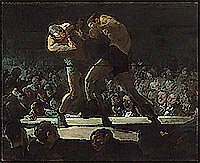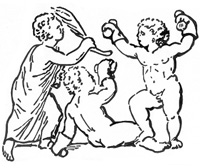While branding was an ancient Roman practice, including branding the face of a slave until late antiquity, the most ancient form of mutilation seems to have been the Egyptian custom of removing the noses from criminals and exiling them to the Sinai. As in most ages, the primary crime in the ancient world was failure to submit to slavery. Many of our laws, ultimately, descend to us down through the ages as evolved tools for social control of forced laborers, or slaves.
Throughout Medieval Christendom and into Early Modern Christian Europe and Plantation America various beatings, mutilations and humiliations were conducted upon people who violated social norms. The most common social norm violated was to run away from bondage or to live without a master as a vagabond, vagrant, pauper, debtor, beggar or minstrel.
The most common punishment was to be locked in stocks, to have one's feet secured so that the offender would sit in humiliation in an early modern form of doxing.
“The stocks were employed by civil and military authorities from medieval to early modern times including Colonial America. Public punishment in the stocks was a common occurrence from around 1500 until at least 1748.[3] The stocks were especially popular among the early American Puritans, who frequently employed the stocks for punishing the "lower class”.”
So goes the sanitized listing of slaves as “the lower class.”
The pillory was much more comic and cruel, as the humiliated person had his wrists and neck locked into a cross and yoke where he might be pelted with refuse, and in Daniel Defoe’s case flowers, have his ears cut off or cropped, his tongue bored or his face branded, and which served as a convenient stand for beatings. The many and varied forms of beatings will be covered in another chapter.
“The criminal could also be sentenced to further punishments while in the pillory: humiliation by shaving off some or all hair or regular corporal punishment(s), notably flagellation (the pillory serving as the "whipping post") or even permanent mutilation such as branding or having an ear cut off (cropping), as in the case of John Bastwick.”
Left out in the sanitized listing above, which only shows outrage at physical pain and damage and glosses over the soul-crushing actuality of slavery, beating and mutilations were usually, especially in the American Plantations, secondary punishments. The most common sentence in England, was death, which could often be exchanged for enslavement as a “convict transport.” In 1637-8, John Bastwick was sentenced to lose his ears at the pillory and be imprisoned for life—though Civil War would save him and put him in the position to pass judgment on others.
In the Plantations, anyone who was pilloried or mutilated was so treated as a symbol and overture of their main sentence, which was to be enslaved for a debt or other crime or have their term of enslavement extended or made permanent after having run away.
“In Protestant cultures (such as in the Scandinavian countries), the pillory would be the worldly part of a church punishment. The delinquent would therefore first serve the ecclesiastical part of his punishment on the pillory bench in the church itself, and then be handed to the worldly authorities to be bound to the Skampåle (literally: "Shame Pole") for public humiliation.”
This whipping post tradition from Sweden, seems to have spread from New Jersey, where the Swedes settled, across the Middle and Southern Plantations. For, while the stocks and pillory dominated in New England, in those places South of New Jersey, the whipping post, or the shame pole in Sweden, was the typical place of reckoning for non-compliant slaves and criminals.
Interestingly, both the British military and Native Americans of the Eastern Woodlands would adopt the Swedish humiliation known as the “Gantalupe” which came to be called “the gauntlet” in which a person was made to run between long files of people of their own sex and age armed with sticks, switches and clubs, who would beat and sometimes kill the runner of the gauntlet.
The chief English variation on mutilation seems to have been boring of a hole in the tongue, often with a hot iron, a sadistic variation on the ancient Israelite custom of boring the ear of a slave.
The chief American innovation was applied to the ancient practice of branding, by which a runaway had an R traced on his face with gunpowder, which was then set alight to brand him. This final act served as the congruence of mutilation and humiliation, as did the crueler ear cropping, as the subject was marked forevermore as beyond the community of Christian Conscience, an evildoer beyond redemption, sentenced to a lifetime of toil on earth and Eternity in Hell.
Sources
link › en.wikipedia.org/wiki/Stocks











